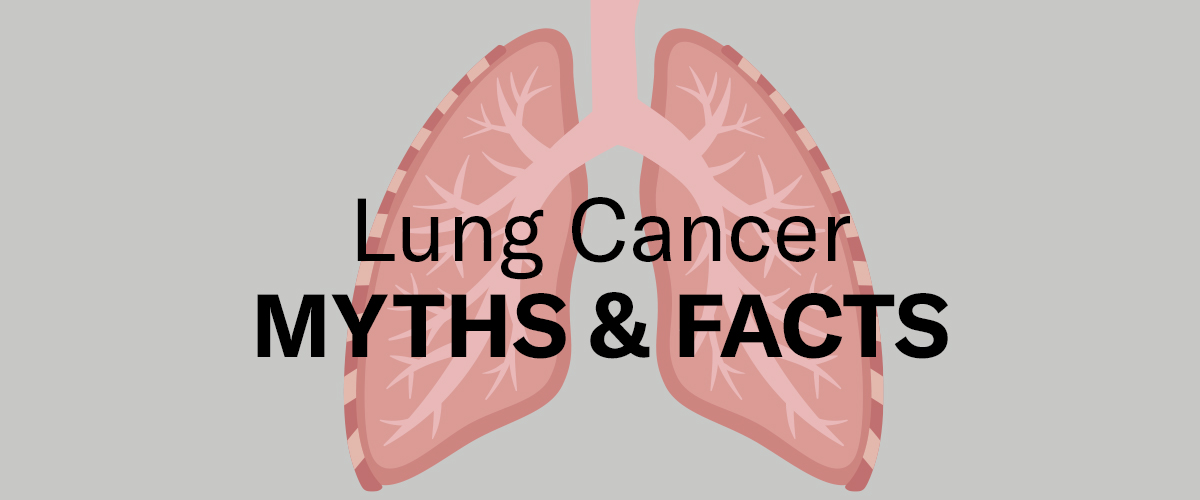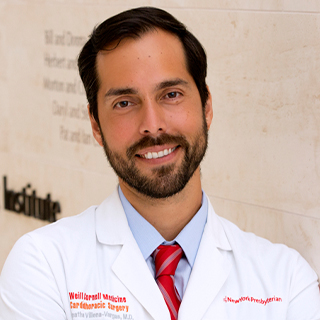Lung Cancer Myths Debunked
An expert explains why it is not only longtime smokers who are at risk for lung cancer and dispels other common misconceptions about the disease.

Lung cancer is the leading cause of cancer death, according to the American Cancer Society (ACS), impacting about 1 in 17 women and 1 in 16 men. In 2023, the ACS estimated that 238,340 people would be diagnosed with lung cancer in the U.S., resulting in about 127,070 deaths.
“One of the reasons that lung cancer is the leading cause of cancer death is because it usually does not present with symptoms when the cancer is in the first or second stage,” says Dr. Jonathan Villena-Vargas, a thoracic surgeon at NewYork-Presbyterian/Weill Cornell Medical Center who specializes in lung and esophageal cancer. “This is why we push for lung cancer screening.”
Typically, patients begin to experience symptoms once the lung cancer has spread or has become large enough to cause symptoms, says Dr. Villena-Vargas, who is also an assistant professor of cardiothoracic surgery at Weill Cornell Medicine. “They can range from coughing, hemoptysis (which is the coughing of blood), chest pain, and shortness of breath, among others, such as unintended weight loss or a hoarse voice.”
Dr. Villena-Vargas spoke with Health Matters to debunk myths surrounding the disease, including who is at risk for lung cancer, screening options, and treatments.

Dr. Jonathan Villena-Vargas
Myth: People who get lung cancer have a history of smoking
While smoking is a risk factor for lung cancer, you do not have to have smoked to get the disease. “About 10% to 20% of lung cancers happen in patients who have never smoked, or who in their lifetime have smoked less than 100 cigarettes,” says Dr. Villena-Vargas. “Diagnoses in these patients are typically due to other risk factors that are not related to smoking.”
These factors include being exposed to radon over a long period of time. Radon, a natural gas that forms in rocks, soil, and water, cannot be detected by sight, taste or smell, but can become trapped in the air inside homes and buildings, according to the Centers for Disease Control and Prevention (CDC). Other factors are secondhand smoke and being around substances or chemicals, such as asbestos, arsenic, diesel, and exhaust, among others.
There is also a risk for lung cancer when there is “a personal or family history, although the reasons are multifactorial and not well understood,” said Dr. Villena-Vargas. In addition, there are populations who are at higher risk for certain types of lung cancer. “For example, in people of East Asian descent, those who have lung cancer are more likely to be female, never smokers, and young. They carry a gene mutation in the epidermal growth factor receptor (EGFR),” he says. EGFR is a protein on cells that helps them grow, but a mutation in the gene for EGFR can make it grow too much, which can cause cancer, states the American Lung Association.
Myth: You can’t screen for lung cancer
While most people know about screenings such as mammograms and colonoscopies, many may not realize that lung cancer screening is also available. The recommended screening test for lung cancer is a low-dose CT scan, according to the U.S. Preventive Services Task Force, which provides detailed pictures of a person’s lungs.
Recently, ACS updated its lung cancer screening guidelines, which made about five million more people in the U.S. eligible for annual screening. “Anybody between the ages of 50 and 80 who currently or formerly smoked, and who has a 20-plus pack-year history should get screened,” says Dr. Villena-Vargas. “But only 4.5% of patients who meet the criteria for screening, get screened. It is even less in underserved populations. That is why we are making a great effort for people to know that it is available, non-invasive, and painless. It can be done in minutes, and it saves lives.”
Myth: I smoke regularly but use other methods of smoking, so I won’t be as affected
“Anything that someone can inhale into their lungs can cause inflammation — sometimes chronic inflammation — which can cause a lot of tissue damage in the lungs,” said Dr. Villena-Vargas. “Whether it be through cigarettes, hookahs, e-cigarettes, or other methods, it can all potentially cause the same thing, which is tissue damage that leads to cancer cell growth.”
It is also important to keep in mind that lung cancer is not the only condition that can arise from smoking habits. “People can also get emphysema, chronic obstructive pulmonary disease, and are also at an increased risk for cardiac disease,” says Dr. Villena-Vargas.
Myth: Lung cancer can’t be treated
Experts have made significant strides in lung cancer treatments in recent years. “There are advances that have changed how we treat lung cancer in the last 10 years and one of them is targeted therapy,” says Dr. Villena-Vargas. “Before this, the only treatment we had for lung cancer was the same options we have had for years, which are surgery, chemotherapy, and radiation. We started finding out that there are specific mutations, like EGFR, which can have targeted therapy; a specific drug to treat the mutation.”
Another advancement is immunotherapy. “The use of the immune system to attack cancer has changed how we treat lung cancer almost at every single stage. This year, several trials proved that patients we operate on can benefit from immunotherapy,” says Dr. Villena-Vargas. “I tell patients now that we have very good treatment options that we did not have five or 10 years ago.”
Jonathan Villena-Vargas, M.D., is a thoracic surgeon at New York-Presbyterian/Weill Cornell Medical Center, who specializes in lung and esophageal cancer. He is also an assistant professor of cardiothoracic surgery at Weill Cornell Medicine and conducts translational immunotherapy research as a member of the Neuberger Berman Lung Cancer Research Center.

